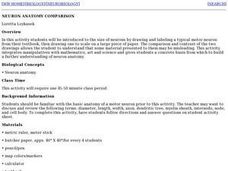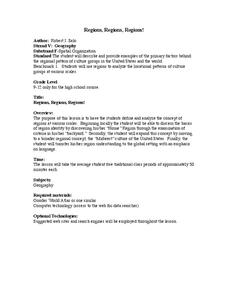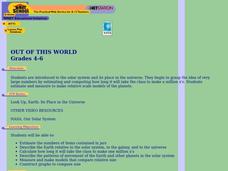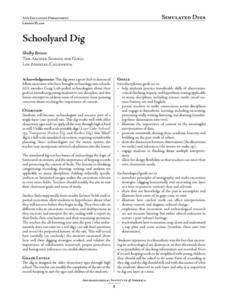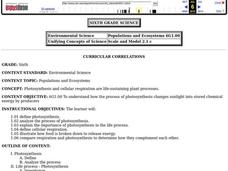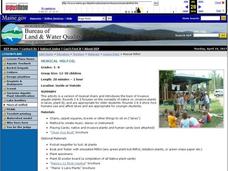Curated OER
Evaluating an Illinois Earthquake
Learners examine the frequency of earthquakes in Illinois. They discover the distribution of earthquakes in the Midwest. They also practice reading measurements from the Richter scale and Mercalli Intensity scale.
Curated OER
6-8 Interior Design: Designing My Dream Room
Students analyze interior design as a profession. For this interior design lesson, students design their own dream bedroom and explore interior design as a profession. Students draw a scaled drawing using graph paper and appropriate...
Curated OER
Simple Machines IV - Wheels and Axles
Fourth graders study everyday examples of simple machines. They examine how the combination of a wheel and axle works more efficiently than either in isolation. In a demonstration lesson, they see how a spring scale shows a force pulling...
Curated OER
How Big Is Your House?
Students create a scale drawing of their own homes. They use geometric formulas to find the area of each room and the total area of the home.
Curated OER
Neuron Anatomy Comparison
Students create a scale model of a motor neuron that is two hundred times larger than the actual neuron. They identify the structures of a neuron and observe neurons under the microscope then use a worksheet to convert actual sizes into...
Curated OER
Regions, Regions, Regions!
Students use regions to analyze the locational patterns of culture
groups at various scales. They discern the basics of region identity by discovering his/her "Home" Region through the examination of
criteria in his/her "backyard." In...
Curated OER
How Big Should My Picture Be?
Students explore water color techniques. In this water color lesson, students examine how to size their drawings. Students discover that water color painting works best on a smaller scale as they create an original piece of art.
Curated OER
Introduction to the Planets
Students become familiar with the members of the solar system and planetary order. They identify differences and characteristics of individual planets. Finally students visualize the great size of the solar system and make the image more...
Curated OER
Out of This World
Students are introduced to the solar system and its place in the universe. They begin to grasp the idea of very large numbers by estimating and computing how long it take the class to make a million x's.
Curated OER
Discovering Friction
Students watch a demonstration that introduces them to the idea that friction is a force that impedes motion when two surfaces are in contact. They work in groups to experiment with frictional force using a coffee cup on which they alter...
Curated OER
Schoolyard Dig
Students begin the lesson by being introduced to the new vocabulary associated with archaeology. In groups, they use the school grounds to simulate their dig site. They record all the objects they discover and what can be gathered from...
Curated OER
Visual Arts Lesson: Writing desk
Sixth graders examine a writing desk. They each make decorative drawers to scale for assembly into a class desk. They use repetitive motifs in their designs.
Curated OER
Supermarket Shopping
Learners participate in studying that a kilogram is a standard unit of measurement. They measure practical objects using length, mass, and capacity. They measure a number of supermarket items using units and scales.
Curated OER
Focus on Friction
The students learn about friction and forces through direct instruction and an investigation. They use measurement skills, observation skills, predicting, and drawing conclusions based on data collected during the investigation. Students...
Curated OER
Photosynthesis
Sixth graders are introduced to the process of photosynthesis by discussion and then by participating in an experiment. They then answer questions as independent practice project.
Curated OER
Creating a Decorative Drawer Front Concealing Student Treasures
Sixth graders describe the image of a writing desk. They create a separate drawer to scale and create a class desk that displays each drawer. Students use repetitive motifs in designing their drawers. To illustrate the use of the desk in...
Curated OER
Rate It - Working With Positive and negative Numbers
Learners practice rating things using numbers between -2 to 2. In this rating lesson, students determine what a rating scale is before rating things such as the weather, a book, or a day using the numbers -2 to 2. They examine the use of...
Curated OER
The Milky Way and Beyond
Students consider the scale of the Milky Way Galaxy. In this Milky Way lesson, students hypothesize the length of time necessary to cross the Milky Way.
Curated OER
Water Contamination Mapping Lab
Students are introduced briefly to the Biscayne Bay Ecosystem, observed microbe distributions and water current maps are introduced. They measure water current speeds to predict the movement of pollutants based on the type of the tidal...
Curated OER
Tree Identification
Students are introduced to the characteristics of trees and different techniques to identify them. They distinguish between a deciduous and a coniferous tree. Students describe at least four characteristics used to identify trees. They...
Curated OER
The Mandelbrot Set
Learners are introduced to the notion of a complex number and function iteration in order to motivate the discussion of Julia sets and the Mandelbrot set.
Curated OER
Translations, Reflections, and Rotations
Students are introduced to the concepts of translation, reflection, and rotation. They practice translating, reflecting, and rotating two-dimensional objects on the coordinate plane. students use computers to learn about the three concepts.
Curated OER
Musical Milfoil
Pupils play a game that is a version of musical chairs to introduce them to invasive aquatic plants. In this aquatic plants lesson plan, students play 4 rounds of this game.
Curated OER
A Peek at the Past: Gradualism vs. Punctuated Equilibria
Learners consider two sets of simulated fossils (caminalcules) that are provided as cutouts. They arrange them on two time scales. One set produces a visual example of gradualism, the other shows punctuated equilibria.




